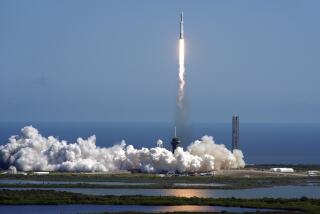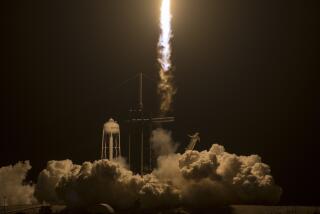Atlantis, Europe’s lab bound for space station at last
- Share via
The space shuttle Atlantis launched Thursday on an 11-day mission to the International Space Station, following weeks of delays and technical glitches that threatened to set back NASA’s station construction schedule.
The spacecraft lifted off from Kennedy Space Center at 2:45 p.m. after thick clouds that could have canceled the launch suddenly broke over the central Florida coastline.
“Looks like today’s a good day and we’re ready to go fly,” said the shuttle commander, Stephen N. Frick.
“We wish you smooth sailing to the New World among the stars,” said launch official Gerry Goodson, making one of many launch-day references to Christopher Columbus’ journey to America. Atlantis is carrying a 10-ton, $2-billion European laboratory module named Columbus in its payload bay. The 23-foot-long, 15-foot-wide lab, which will support biology and physics experiments in space, is Europe’s major contribution to the space station.
Scores of European scientists and politicians gathered at Kennedy for the much-awaited event. They celebrated the launch with Belgian and French chocolates, as well as grape juice, a substitute for champagne in keeping with NASA’s rules against alcohol.
“It’s not very European,” joked Italian astronaut Paolo Nespoli, as he poured juice into wine glasses.
“This is one of the more significant shuttle launches we’ll ever have,” said NASA Administrator Michael Griffin. “It brings to the space station truly international participation. It shows this is a real partnership among nations.”
The launch appeared to go smoothly, although cameras on the ground and on the spacecraft saw three possible incidents of ice or insulating foam flaking off the external fuel tank.
Debris has assumed greater importance since the shuttle Columbia was destroyed by a piece of foam hitting its left wing in 2003.
The final verdict on the health of the shuttle won’t be rendered for several days, after Atlantis docks Saturday at the space station.
But the early analysis raised no concerns, officials said. “There wasn’t anything in the imagery that we didn’t think we could explain or haven’t seen before,” said LeRoy Cain, chairman of the mission management team.
After several years of study, NASA engineers have concluded that flaking foam is dangerous only during a narrow window of time, when the launch speed and the thickness of the atmosphere combine to accelerate debris to a destructive level.
“We’re coming back -- and I think we are back -- from some pretty severe technical problems that led to the loss of Columbia. We understand the foam now,” Griffin said.
When installed Sunday during the first of three scheduled spacewalks, the Columbus lab will join the American-built laboratory, Destiny. The much bigger Japanese lab, Kibo, or Hope, will require three shuttle flights, beginning in March.
Thursday’s launch was delayed by two months because of problems with four fuel sensors inside the external fuel tank that are designed to shut off the engines before the tank runs out of fuel. NASA redesigned the sensors, and all four worked perfectly during the countdown.
The sensor problem complicates NASA’s effort to finish construction of the space station by the time the shuttles are retired in 2010. The shuttle program managed only three flights last year but hopes to make up ground with as many as six flights this year.
One is a planned repair mission to the Hubble Space Telescope.
William H. Gerstenmaier, associate NASA administrator, said that schedule delays don’t necessarily cause problems down the line. “A lot of times we can make things up,” he said. “We want to fly these [missions] safely and take them one at a time.”
Frick is head of a seven-man crew, one of whom, French air force Brig. Gen. Leopold Eyharts, will join the space station crew and remain behind when the shuttle returns to Earth. He will replace Daniel Tani, who will return aboard the shuttle, ending a mission of nearly four months.
--
The Associated Press contributed to this report.
More to Read
Sign up for Essential California
The most important California stories and recommendations in your inbox every morning.
You may occasionally receive promotional content from the Los Angeles Times.










